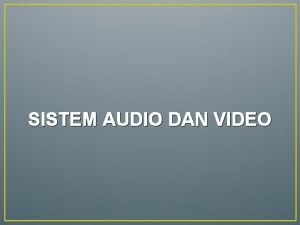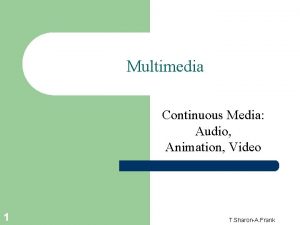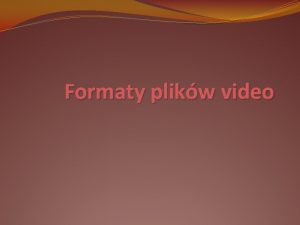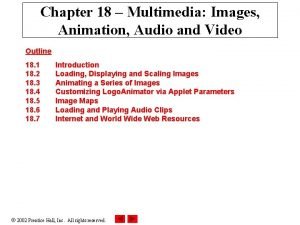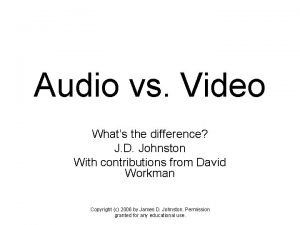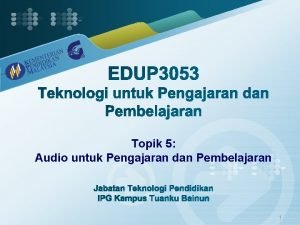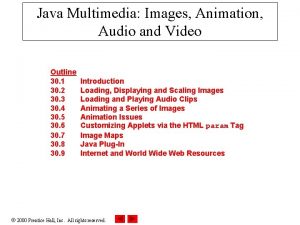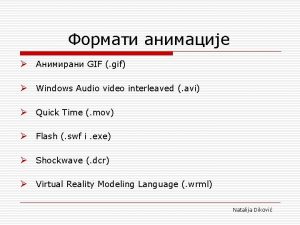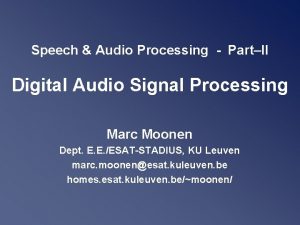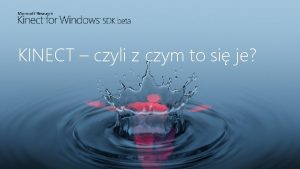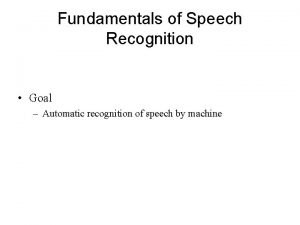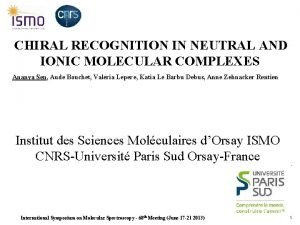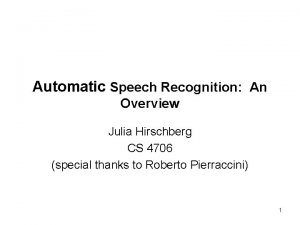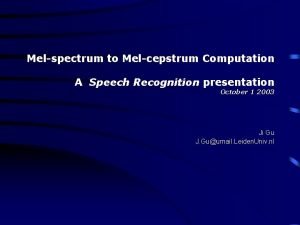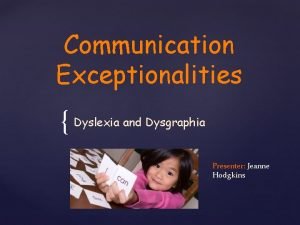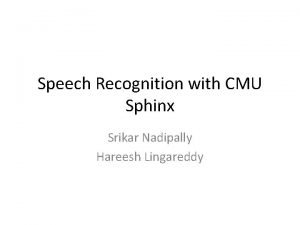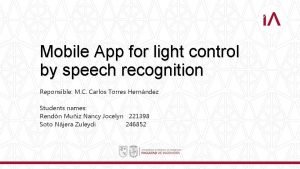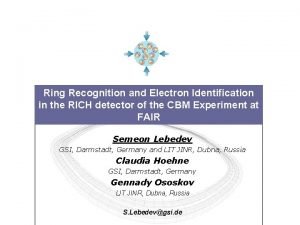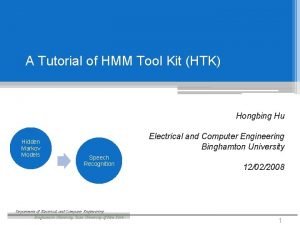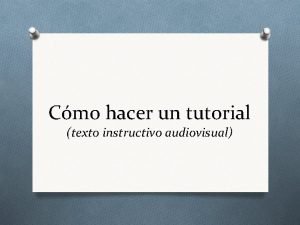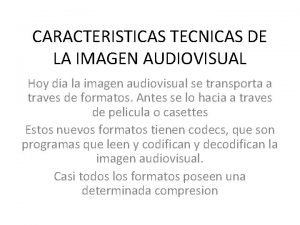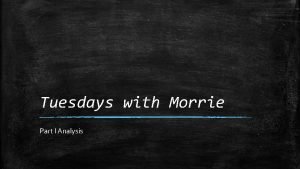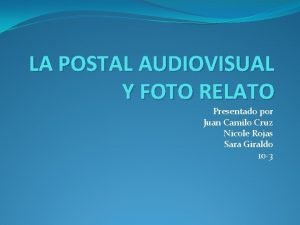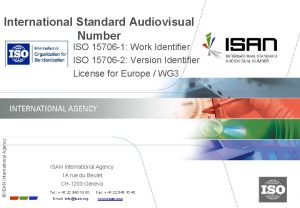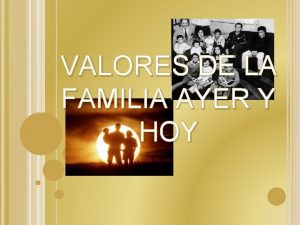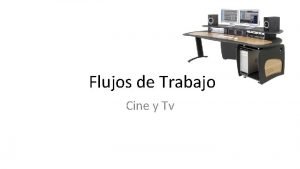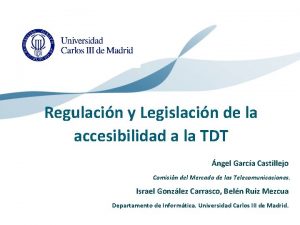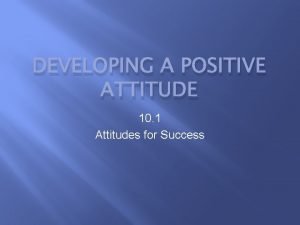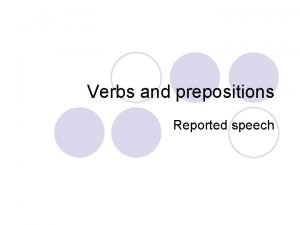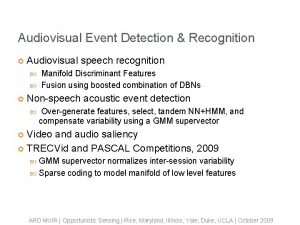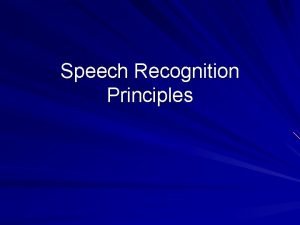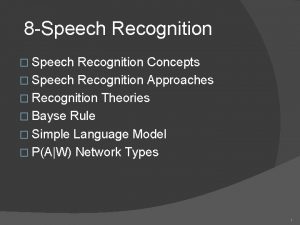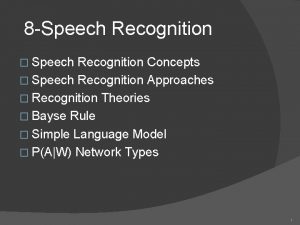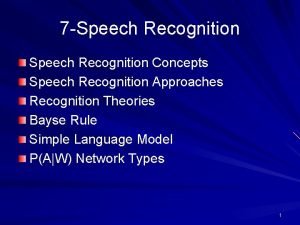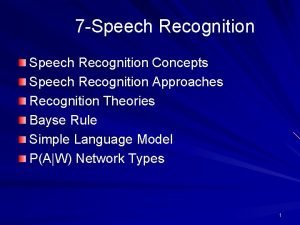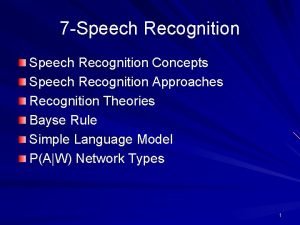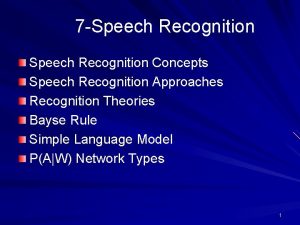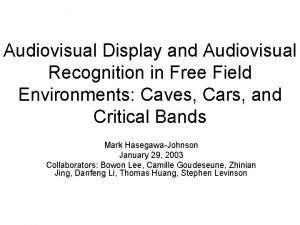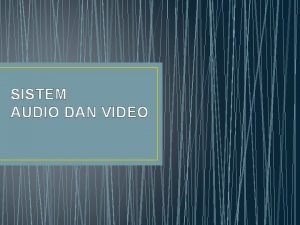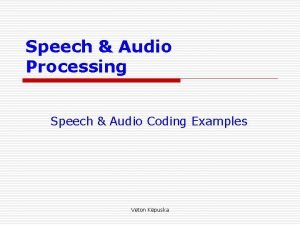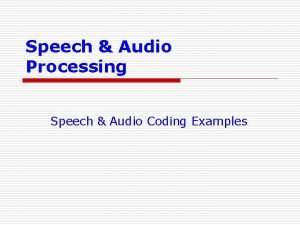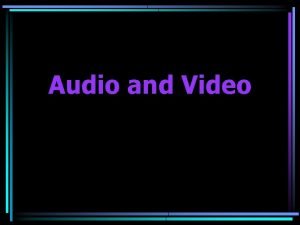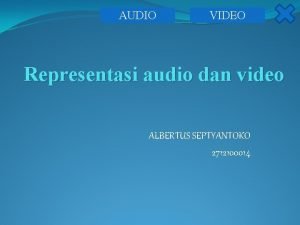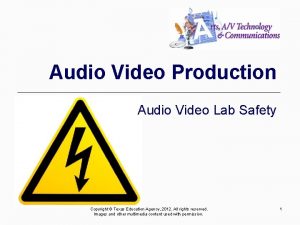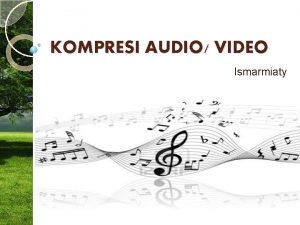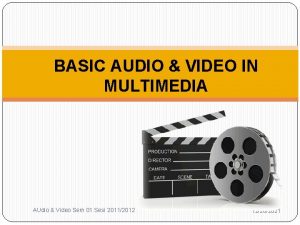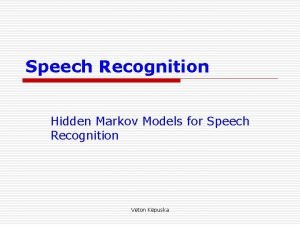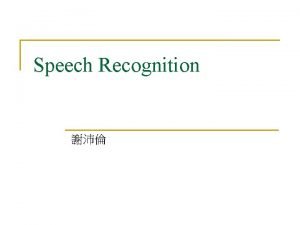AudioVisual Speech Recognition Audio Noise Video Noise and







































- Slides: 39

Audio-Visual Speech Recognition: Audio Noise, Video Noise, and Pronunciation Variability Mark Hasegawa-Johnson Electrical and Computer Engineering

Audio-Visual Speech Recognition 1) Video Noise 1) Graphical Methods: Manifold Estimation 2) Local Graph Discriminant Features 2) Audio Noise 1) Beam-Form, Post-Filter, and Low-SNR VAD 3) Pronunciation Variability 1) Graphical Methods: Dynamic Bayesian Network 2) An Articulatory-Feature Model for Audio-Visual Speech Recognition

I. Video Noise 1) Graphical Methods: Manifold Estimation 2) Local Graph Discriminant Features 2) Audio Noise 1) Beam-Form, Post-Filter, and Low-SNR VAD 3) Pronunciation Variability 1) Graphical Methods: Dynamic Bayesian Network 2) An Articulatory-Feature Model for Audio-Visual Speech Recognition

AVICAR Database ● ● ● AVICAR = Audio-Visual In a CAR 100 Talkers 4 Cameras, 7 Microphones 5 noise conditions: Engine idling, 35 mph with windows open, 55 mph with windows open Three types of utterances: – Digits & Phone numbers, for training and testing phonenumber recognizers – TIMIT sentences, for training and testing large vocabulary speech recognition – Isolated Letters, to test the use of video for an acoustically hard recognition problem

AVICAR Recording Hardware (Lee, Hasegawa-Johnson et al. , ICSLP 2004) 8 Mics, Pre-amps, Wooden Baffle. 4 Cameras, Glare Shields, Adjustable Mounting Best Place= Dashboard Best Place= Sunvisor. System is not permanently installed; mounting requires 10 minutes.

AVICAR Video Noise § Lighting: Many different angles, many types of weather § Interlace: 30 fps NTSC encoding used to transmit data from camera to digital video tape § Facial Features: – Hair – Skin – Clothing – Obstructions

AVICAR Noisy Image Examples

Related Problem: Dimensionality § Dimension of the raw grayscale lip rectangle: 30 x 200=6000 pixels § Dimension of the DCT of the lip rectangle: 30 x 200=6000 dimensions § Smallest truncated DCT that allows a human viewer to recognize lip shapes (Hasegawa-Johnson, informal experiments): 25 x 25=625 dimensions § Truncated DCT typically used in AVSR: 4 x 4=16 dimensions § Dimension of “geometric lip features” that allow high-accuracy AVSR (e. g. , Chu and Huang, 2000): 3 dimensions (lip height, lip width, vertical assymmetry)

Dimensionality Reduction: The Classics Principal Components Analysis (PCA): § Project onto eigenvectors of the total covariance matrix § Projection includes noise Linear Discriminant Analysis (LDA): § Project onto v=W-1(dm), W=within-class covariance § Projection reduces noise

Manifold Estimation (e. g. , Roweis and Saul, Science 2000) Neighborhood Graph § Node = data point § Edge = connect each data point to its K nearest neighbors Manifold Estimation § The K nearest neighbors of each data point define the local (K-1)-dimensional tangent space of a manifold

Local Discriminant Graph (Fu, Zhou, Liu, Hasegawa-Johnson and Huang, ICIP 2007) Maximize Local Inter. Manifold Interpolation Errors, subject to a constant Same. Class Interpolation Error: Find P to maximize e. D = Si||PT(xi-Skckyk)||2, yk Є KNN(xi), other classes Subject to e. S = constant, e. S = Si||PT(xi-Sjcjxj)||2, xj Є KNN(xi), same class

PCA, LDG: Experimental Test (Fu, Zhou, Liu, Hasegawa-Johnson and Huang, ICIP 2007) Lip Feature Extraction: DCT=discrete cosine transform; PCA=principal components analysis; LDA=linear discriminant analysis; LEA=local eigenvector analysis; LDG=local discriminant graph

Lip Reading Results (Digits) (Fu, Zhou, Liu, Hasegawa-Johnson and Huang, ICIP 2007) DCT=discrete cosine transform; PCA=principal components analysis; LDA=linear discriminant analysis; LEA=local eigenvector analysis; LDG=local discriminant graph

II. Audio Noise 1) Video Noise 1) Graphical Methods: Manifold Estimation 2) Local Graph Discriminant Features 2) Audio Noise 1) Beam-Form, Post-Filter, and Low-SNR VAD 3) Pronunciation Variability 1) Graphical Methods: Dynamic Bayesian Network 2) An Articulatory-Feature Model for Audio-Visual Speech Recognition

Audio Noise

Audio Noise Compensation § Beamforming – Filter-and-sum (MVDR) vs. Delay-and-sum § Post-Filter – MMSE log spectral amplitude estimator (Ephraim and Malah, 1984) vs. Spectral Subtraction § Voice Activity Detection – Likelihood ratio method (Sohn and Sung, ICASSP 1998) – Noise estimates: § Fixed noise § Time-varying noise (autoregressive estimator) § High-variance noise (backoff estimator)

MVDR Beamformer + MMSElog. SA Postfilter (MVDR = Minimum variance distortionless response) (MMSElog. SA = MMSE log spectral amplitude estimator) (Proof of optimality: Balan and Rosca, ICASSP 2002)

Word Error Rate: Beamformers § Ten-digit phone numbers; trained and tested with 50/50 mix of quiet (idle) and noisy (55 mph open) § DS=Delay-and-sum; MVDR=Minimum variance distortionless response

Word Error Rate: Postfilters

Voice Activity Detection § Most errors at low SNR are because noise gets misrecognized as speech § Effective solution: voice activity detection (VAD) § Likelihood ratio VAD (Sohn and Sung, ICASSP 1998): Lt = log { p(Xt=St+Nt) / p(Xt=Nt) } Xt = Measured Power Spectrum St, Nt = Exponentially Distributed Speech, Noise Lt > threshold → Speech Present Lt < threshold → Speech Absent

VAD: Noise Estimators § Fixed estimate: N 0=average of first 10 frames § Autoregressive estimator (Sohn and Sung): Nt = bt Xt + (1 -bt) Nt-1 bt = function of Xt, N 0 § Backoff estimator (Lee and Hasegawa. Johnson, DSP for In-Vehicle and Mobile Systems, 2007): Nt = bt Xt + (1 -bt) N 0

Word Error Rate: Digits

III. Pronunciation Variability 1) Video Noise 1) Graphical Methods: Manifold Estimation 2) Local Graph Discriminant Features 2) Audio Noise 1) Beam-Form, Post-Filter, and Low-SNR VAD 3) Pronunciation Variability 1) Graphical Methods: Dynamic Bayesian Network 2) An Articulatory-Feature Model for Audio-Visual Speech Recognition

Graphical Methods: Dynamic Bayesian Network § Bayesian Network = A Graph in which § Nodes are Random Variables (RVs) § Edges Represent Dependence § Dynamic Bayesian Network = A BN in which § RVs are repeated once per time step § Example: an HMM is a DBN § Most important RV: the “phonestate” variable qt § Typically qt Є {Phones} x {1, 2, 3} § Acoustic features xt and video features yt depend on qt

Example: HMM is a DBN wt-1 wt winct-1 ft-1 qt-1 xt-1 ft qt qinct-1 yt-1 winct xt qinct yt Frame t-1 Frame t § qt is the phonestate, e. g. , qt Є { /w/1, /w/2, /w/3, /n/1, /n/2, … } § wt is the word label at time t, for example, wt Є {“one”, “two”, …} § ft is the position of phone qt within word wt: ft Є {1 st, 2 nd, 3 rd, …} § qinct Є {0, 1} specifies whether ft+1=ft or ft+1=ft+1

Pronunciation Variability § Even when reading phone numbers, talkers “blend” articulations. § For example: “seven eight: ” /sevәnet/→ /sevne? / § As speech gets less formal, pronunciation variability gets worse, e. g. , worse in a car than in the lab; worse in conversation than in read speech

A Related Problem: Asynchrony § Audio and Video information are not synchronous § For example: “th” (/q/) in “three” is visible, but not yet audible, because the audio is still silent § Should HMM be in qt=“silence, ” or qt=/q/?

A Solution: Two State Variables (Chu and Huang, ICASSP 2000) wt-1 winct-1 ft-1 qinct-1 qt-1 xt-1 dt-1 bt-1 vt-1 wt winct ft qt xt qinct dt bt vinct-1 yt-1 Frame t-1 vt vinct yt Frame t § Coupled HMM (CHMM): Two parallel HMMs § qt: Audio state (xt: audio observation) § vt: Video state (yt: video observation) § d t = b t -f t : Asynchrony, capped at |dt|<3

Asynchrony in Articulatory Phonology (Livescu and Glass, 2004) § It’s not really the AUDIO and VIDEO that are ssynchronous… § It is the LIPS, TONGUE, and GLOTTIS that are asynchronous word ind 1 U 1 sync 1, 2 S 1 ind 2 U 2 sync 2, 3 S 2 ind 3 U 3 S 3

Asynchrony in Articulatory Phonology § It’s not really the AUDIO and VIDEO that are ssynchronous… § It is the LIPS, TONGUE, and GLOTTIS that are asynchronous “three, ” dictionary form Tongue Glottis Dental /q/ Silent Retroflex /r/ Unvoiced Palatal /i/ Voiced time “three, ” casual speech Tongue Glottis Dental /q/ Silent Unvoiced Retroflex /r/ Palatal /i/ Voiced

Asynchrony in Articulatory Phonology § Same mechanism represents pronunciation variability: – “Seven: ” /vәn/→ /vn/ if tongue closes before lips open – “Eight: ” /et/ → /e? / if glottis closes before tongue tip closes “seven, ” dictionary form: /sevәn/ Lips Fricative /v/ Tongue Fricative /s/ Wide /e/ Neutral /ә/ Closed /n/ “seven, ” casual speech: /sevn/ Lips Tongue time Fricative /v/ Fricative /s/ Wide /e/ Neutral /ә/ Closed /n/ time

An Articulatory Feature Model (Hasegawa-Johnson, Livescu, Lal and Saenko, ICPh. S 2007) wt-1 winct-1 lt-1 tt-1 gt-1 linct-1 dt-1 tinct-1 et-1 ginct-1 wt winct lt lt tt tt gt gt linct dt tinct et ginct § There is no “phonestate” variable. Instead, we use a vector qt→[lt, tt, gt] – Lipstate variable lt – Tonguestate variable tt – Glotstate variable gt

Experimental Test (Hasegawa-Johnson, Livescu, Lal and Saenko, ICPh. S 2007) § Training and test data: CUAVE corpus – Patterson, Gurbuz, Turfecki and Gowdy, ICASSP 2002 – 169 utterances used, 10 digits each, silence between words – Recorded without Audio or Video noise (studio lighting; silent bkgd) § Audio prepared by Kate Saenko at MIT – NOISEX speech babble added at various SNRs – MFCC+d+dd feature vectors, 10 ms frames § Video prepared by Amar Subramanya at UW – Feature vector = DCT of lip rectangle – Upsampled from 33 ms frames to 10 ms frames § Experimental Condition: Train-Test Mismatch – Training on clean data – Audio/video weights tuned on noise-specific dev sets – Language model: uniform (all words equal probability), constrained to have the right number of words per utterance

Experimental Questions (Hasegawa-Johnson, Livescu, Lal and Saenko, ICPh. S 2007) 1) Does Video reduce word error rate? 2) Does Audio-Video Asynchrony reduce word error rate? 3) Should asynchrony be represented as 1) Audio-Video Asynchrony (CHMM), or 2) Lips-Tongue-Glottis Asynchrony (AFM) 4) Is it better to use only CHMM, only AFM, or a combination of both methods?

Results, part 1: Should we use video? Answer: YES. Audio-Visual WER < Single-stream WER

Results, part 2: Are Audio and Video be asynchronous? Answer: YES. Async WER < Sync WER.

Results, part 3: Should we use CHMM or AFM? Answer: DOESN’T MATTER! WERs are equal.

Results, part 4: Should we combine systems? Answer: YES. Best is AFM+CH 1+CH 2 ROVER

Conclusions § Video Feature Extraction: – Manifold discriminant is better than a global discriminant § Audio Feature Extraction: – Beamformer: Delay-and-sum beats Filter-and-sum – Postfilter: Spectral subtraction gives best WER (though MMSE-log. SA sounds best) – VAD: Backoff noise estimation works best in this corpus § Audio-Video Fusion: – – – Video reduces WER in train-test mismatch conditions Audio and video are asynchronous (CHMM) Lips, tongue and glottis are asynchronous (AFM) It doesn’t matter whether you use CHMM or AFM, but. . . Best result: combine both representations
 Jelaskan kegunaan sistem audio video
Jelaskan kegunaan sistem audio video Image is a continuous media.
Image is a continuous media. Audio web video conferencing
Audio web video conferencing Audio video interleaved
Audio video interleaved Animation audio video
Animation audio video Audio vs video
Audio vs video Audio untuk video pembelajaran
Audio untuk video pembelajaran Video outline
Video outline Windows longhorn gif
Windows longhorn gif Companding in pcm
Companding in pcm Acoustic echo cancellation challenge
Acoustic echo cancellation challenge Kinect for windows runtime
Kinect for windows runtime Fundamentals of speech recognition
Fundamentals of speech recognition Deep learning speech recognition
Deep learning speech recognition Aude leperre
Aude leperre Julia speech recognition
Julia speech recognition Melspectrum
Melspectrum How dyslexic see words
How dyslexic see words Cmu speech recognition
Cmu speech recognition Speech recognition
Speech recognition Speech recognition app inventor
Speech recognition app inventor Dragon speech recognition
Dragon speech recognition Electron speech to text
Electron speech to text Htk speech recognition tutorial
Htk speech recognition tutorial Education audiovisual and culture executive agency eacea
Education audiovisual and culture executive agency eacea Video yandex
Video yandex Gravity yahoo
Gravity yahoo Searchyahoo
Searchyahoo Digital media primer
Digital media primer Aspectos morfologicos lenguaje audiovisual
Aspectos morfologicos lenguaje audiovisual Texto audiovisual
Texto audiovisual Caracteristicas de la imagen audiovisual
Caracteristicas de la imagen audiovisual How did mitch's uncle's death change mitch
How did mitch's uncle's death change mitch Postal audiovisual
Postal audiovisual Isan number
Isan number Valores de ayer y hoy
Valores de ayer y hoy Flujo de trabajo audiovisual
Flujo de trabajo audiovisual Ley comunicacion audiovisual
Ley comunicacion audiovisual Recognition and regard for oneself and one's abilities: *
Recognition and regard for oneself and one's abilities: * Reported speech prepositions
Reported speech prepositions
